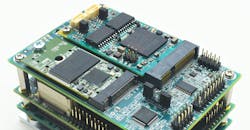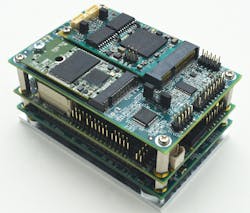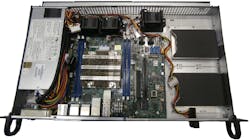M.2, NVMe Bring Performance and Capacity to Modules and Motherboards
Download this article as a .PDF
The M.2 memory and peripheral expansion form factor is very popular in PC motherboards and mobile devices like laptops where compact storage is a requirement. It is also starting to show up in embedded motherboards and modules like Diamond Systems’ Zeta COM Express Type 10 SBC family (Fig. 1). The Zeta 84-mm by 55-mm stack actually has a heat spreader on the bottom with the COM Express module in the middle. The white connector on the top carrier board provides a stackable expansion, such as Diamond Systems’ expansion board with the M.2 and Mini-PCIe sockets.
1. Diamond Systems Zeta COM Express SBC family can work with carrier boards that include Mini-PCIe and M.2.
The Zeta COM Express supports up to 8 Gbytes of RAM and a 1.1 GHz, quad core, Intel Apollo Lake N4200 processor. The fanless design has a -40 to +85°C operating temperature range. The main carrier board includes a 16-channel, 16-bit ADC and a four-channel, 16-bit DAC in addition to connectors for dual gigabit Ethernet, GPIO, four serial ports, an SD card socket, and a Mini-PCIe socket.
Mini-PCIe has become a popular peripheral expansion option for embedded systems. Mini-PCIe cards are available with everything from ADCs to motor control. Of course, there are plenty of wireless options as well. The M.2 form factor can also be used for peripherals, but it is primarily being used for storage. The M.2 B Key provides support for x2 PCI Express (PCIe), SATA, USB 2.0 and 3.0, audio, UIM, HSIC, SSIC, I2C, and SMBus. The M.2 M Key provides x4 PCIe, SATA, and SMBus. NVMe can work with any PCIe interface.
Super Micro Computer’s 5019D-FN8TP (Fig. 2) is built around the X11SDV-8C-TP8F motherboard the runs an 80W, 8-core/16-thread, Intel Xeon-D D-2146NT processor with up to 512 Gbytes of EDD LRDIMM memory. It targets applications like network appliances, digital signage, and IoT servers. It can handle a pair of 3.5-in. drives or four 2.5-in. drives.
2. Supermicro 5019D-FN8TP system has a motherboard that includes an M.2 B Key socket and a Mini-PCIe socket with mSATA support.
For expansion, the motherboard has a M.2 M Key socket for storage, an M.2 B Key socket that can be used for storage or wireless network cards, and a Mini-PCIe socket with mSATA support. There is also a x8 PCIe slot. The system has four 1-Gigabit Ethernet ports, two 10GBase-T ports and two 10G SFP+ ports. It has a dozen SATA 3 ports.
M.2 may eventually be the form factor of choice for peripheral expansion, but for now it tends to be limited to storage and some wireless interfaces. Mini-PCIe is the form factor where there are many options for interface cards. Most Mini-PCIe solid-state drives are mSATA devices that use a SATA interface. In theory, an NVMe Mini-PCIe card could be created, but most NVMe cards are implemented as M.2 devices. The x1 or x4 PCIe interfaces are the most common.
3. Some examples of rugged Mini-PCIe adapters including Connect Tech’s 16-channel, 16-bit ADC (a) and VersaLogic’s Advanced GPS controller (b).
One challenge for embedded developers is finding devices that meet their ruggedness requirements. M.2 devices and even many Mini-PCIe devices are designed for PCs or other applications that are not as demanding. Luckily, most Mini-PCIe peripheral cards are designed with embedded applications in mind (Fig. 3). Connect Tech’s 16-channel, 16-bit ADC operates at 500 K samples/s. VersaLogic’s Advanced GPS controller has an on-board battery to maintain satellite position data to support fast restart of the GPS chip. Both support an extended industrial temperature range of −40°C to +85°C.
4. Examples of M.2 devices include Advantech’s LoRA wireless adapter (a) and Virtium’s family of rugged M.2 storage (b).
Likewise, more M.2 devices that meet embedded temperature and ruggedness are becoming available (Fig 4). Advantech supports LoRAWAN, a long-range, low-speed wireless protocol using its M.2 adapter. Virtium’s StorFly family of M.2 flash cards highlight rugged memory devices that are available. This includes SLC, iMLC, and MLC options as embedded applications often have different requirements for endurance and capacity. These cards are also designed for industrial temperature ranges.
About the Author
William G. Wong
Senior Content Director - Electronic Design and Microwaves & RF
I am Editor of Electronic Design focusing on embedded, software, and systems. As Senior Content Director, I also manage Microwaves & RF and I work with a great team of editors to provide engineers, programmers, developers and technical managers with interesting and useful articles and videos on a regular basis. Check out our free newsletters to see the latest content.
You can send press releases for new products for possible coverage on the website. I am also interested in receiving contributed articles for publishing on our website. Use our template and send to me along with a signed release form.
Check out my blog, AltEmbedded on Electronic Design, as well as his latest articles on this site that are listed below.
You can visit my social media via these links:
- AltEmbedded on Electronic Design
- Bill Wong on Facebook
- @AltEmbedded on Twitter
- Bill Wong on LinkedIn
I earned a Bachelor of Electrical Engineering at the Georgia Institute of Technology and a Masters in Computer Science from Rutgers University. I still do a bit of programming using everything from C and C++ to Rust and Ada/SPARK. I do a bit of PHP programming for Drupal websites. I have posted a few Drupal modules.
I still get a hand on software and electronic hardware. Some of this can be found on our Kit Close-Up video series. You can also see me on many of our TechXchange Talk videos. I am interested in a range of projects from robotics to artificial intelligence.






